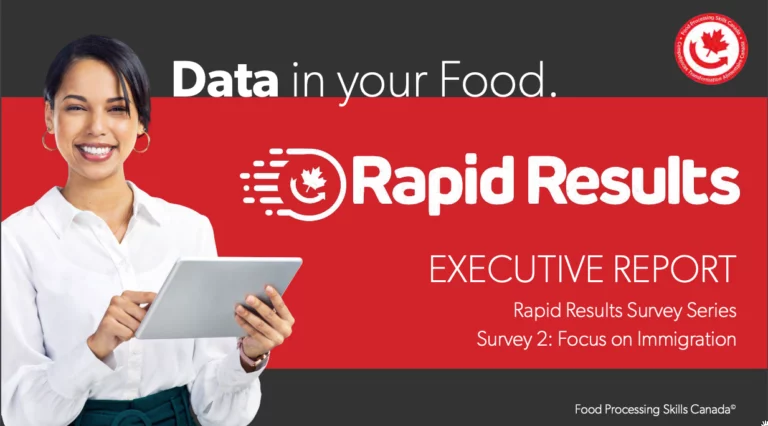
In response to demand for more current labour market information, Food Processing Skills Canada developed the Rapid Results Employer Opinion Panel. As G.I. Joe said, “knowing is half the battle” and getting up to date industry information gets you more informed to meet the challenges that you face. The panelists will be asked to complete 6 surveys, each with a different theme relevant to the industry. This is the second report in the Rapid Results Series and the theme is Immigration and Recruitment
This was designed to be a national panel covering all food and beverage processing sectors. It is conducted at the facility level to be able to capture differences in the size of facilities or the location of facilities. Each survey has 2 sets of questions: core questions that will be asked during every survey and theme questions asked during this specific survey.
The survey was administered from August 1 – August 31, 2023. The response rate was 33% (39 of 119 total Employer Panelists completed it).
In order to get a sense of recency, and track changes over the next year or so, we set the timeframe for many of the questions in this survey as “in the period between May 31, 2023 and now (now being Aug 2023)”.
In the Canadian food and beverage processing industry, this panel was established to collect real-time data on the most relevant issues, including recruitment and retention, supply chains, and rising costs. Results will be shared across Canada to provide critical information to guide labour and employment solutions for the industry.
Food Processing Skills Canada Is pleased to present this research, which will help both industry and governments make key business decisions quickly.
No more waiting to get the latest data.
The theme for this survey was Immigration.
We had a panelist response rate of 33%, over half of whom employ recent immigrants and international skilled workers. 63% of respondents rated their experience of recruiting recent immigrants as “successful”, and most used the approach of encouraging referrals from current employees. Other key sources of recent immigrant hires include the use of an immigration consultant or recruitment agency and partnering with local colleges and universities to hire post-graduates.
Over half (54%) of respondents currently recruit workers from outside of Canada, and 70% are successful. Over half (53%) of respondents who have never recruited workers from outside of Canada would consider recruiting international skilled workers. The top countries for recruiting international skilled workers are the Philippines and Mexico.
For hiring, the top two federal and provincial programs that respondents have used are the Temporary Foreign Workers Program (74%) and Provincial Nominee Programs (48%).
For respondents who are not currently recruiting workers from outside of Canada, cost is the top challenge, with 33% indicating that it is too expensive to navigate the immigration system. Over a quarter also say they don’t understand the process and that it’s complicated. Most companies indicate a greater need for permanent workers, compared to temporary workers.
About 7 in 10 employers allow additional onboarding time for recent immigrants or international skilled workers, and over half are interested in providing or funding language training.
Most respondents (over 80%) agree that immigrants bring economic benefits to the Canadian economy and unique perspectives that can lead to new ideas. The workforce is now more diverse compared to a few years ago, but only 23% agree that current immigration systems serve their needs well.
We learned that in this period, recruitment challenges have increased or stayed the same for the majority of employers (62%, down from 76% in June 2023). The new hire rate is 72%, which is also down from 86% in June 2023.
Similar to June 2023, new hires come predominantly from applications received through private job sites (74%) as well as employee referrals (65%).
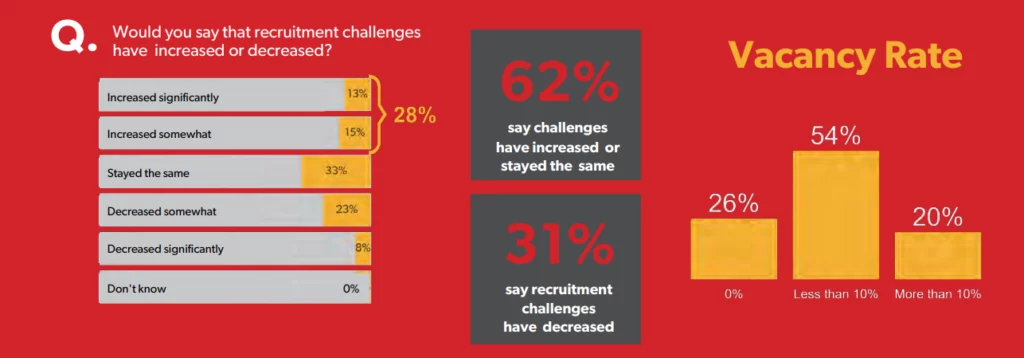
80% of respondents hired new staff in the survey period (down from 86% in March 31 – May 31, 2023). There was a large preference for traditional domestic hiring sources such as private job boards and referrals from existing employees. Job search sites and company websites continue to be two of the top places people look for new jobs.
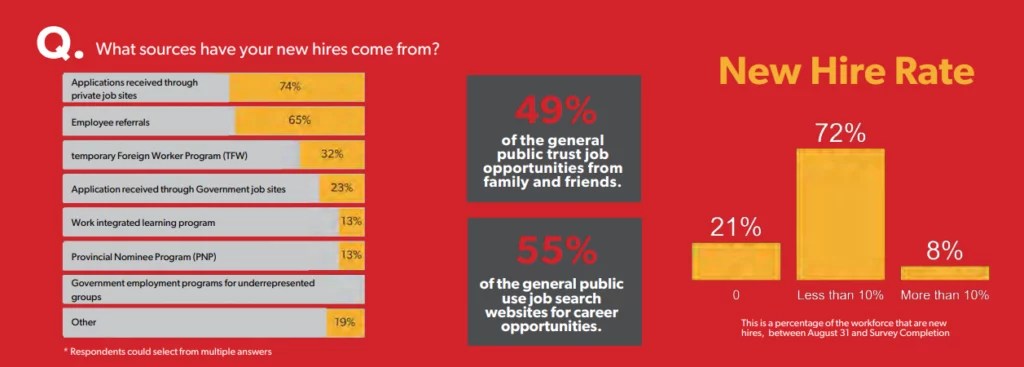
Average Starting Wages are
slightly up since May.
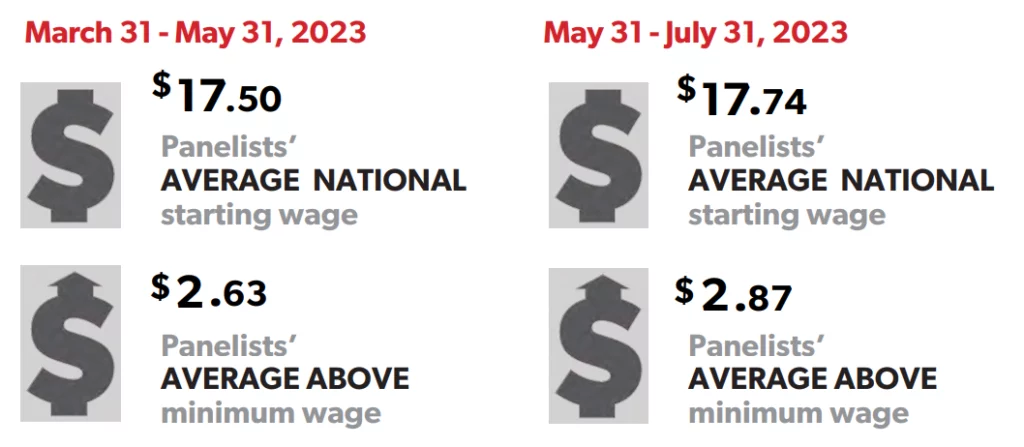
Most respondents are optimistic about their business (72%) and the future of the Canadian food and beverage processing sector (72%). However, these two data points are down slightly from June 2023 (81% and 75%, respectively).
Similar to June 2023, 40% are investing in innovation (and a majority of businesses expect to continue to over the next six months).
This optimism is encouraging. Having this outlook about one’s business can be beneficial in several ways. This optimism could be the foundation needed to stay motivated and focused on goals, to help businesses make better decisions, to attract customers, employees, and innovators to businesses, and to ultimately create and foster a positive work environment.
Panelists are optimistic about the future.
About half of respondents felt that current supply issues are negatively affecting business and that hiring and retaining people is more challenging, down from 53% in June 2023. Respondents also believe that the industry will overcome these challenges, as 72% are optimistic about the future of the industry and the future of their business.
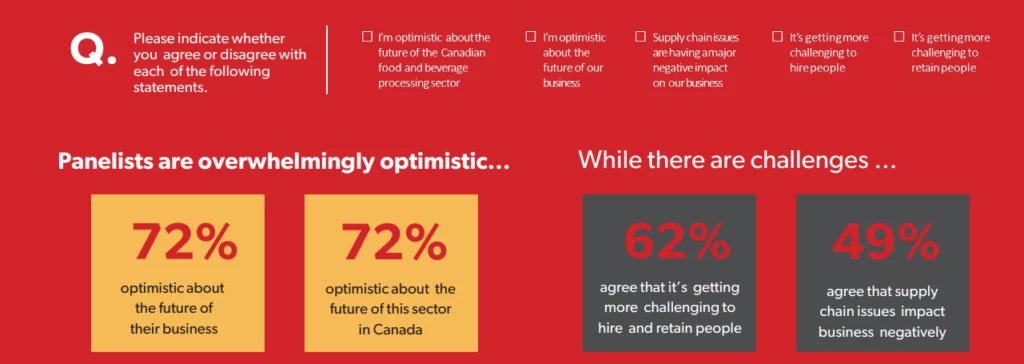
Automation, digitization, and wireless interconnectivity are vital methods that businesses can use to become more efficient and overcome labour shortages. Fewer respondents indicate having made investments in innovations across all functional areas in this reporting period, compared to the previous one (March 31 – May 31, 2023). Planned investments for the future have also dropped slightly across the board.
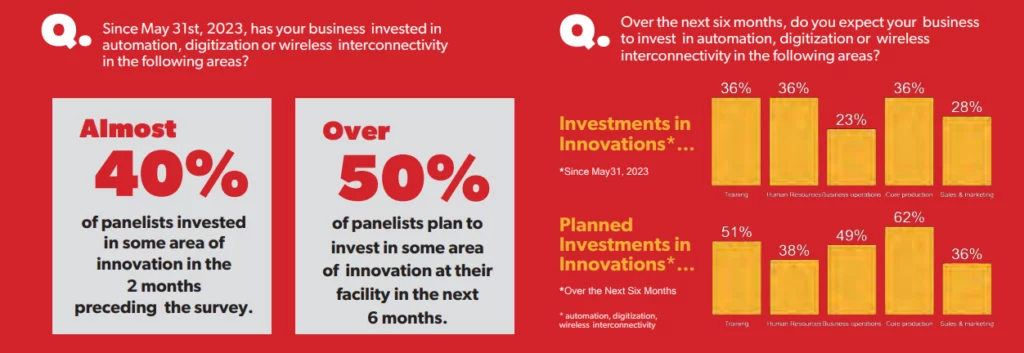
Most respondents have positive perceptions of immigrants in the workforce. A large majority (over 80%) agree that immigrants benefit Canada’s economy, that they bring diverse and unique perspectives that can lead to new ideas, and that the current workforce is much more diverse than it was a few years ago.
This data is both positive and encouraging, as it highlights Canadian businesses’ understanding of the importance of and their openness towards hiring immigrants and equity-deserving groups.
While recognizing their workforces are more diverse than before, some respondents are still experiencing challenges in integrating immigrants into their operations. There is a lot of training available, including a course called “Canadian Workplace Cultures” from FPSC that can help smooth the integration of international workers into your business.
More than 80% of respondents agree that immigrants bring economic benefits to the Canadian economy and that foreign nationals can bring unique perspectives that can lead to new ideas. However, less than a quarter of respondents agree that the current immigration system serves their needs well.
Most companies also agree that their workforce is much more culturally diverse compared to a few years ago. However, only 1 in 5 companies offer English as a Second Language training to newcomers.
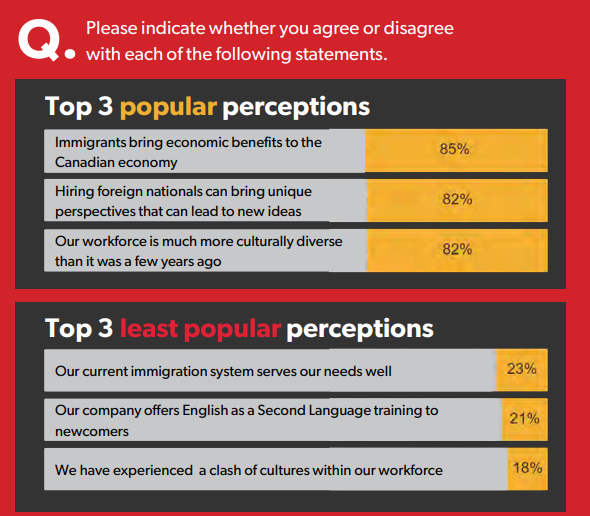
Almost 7 in 10 businesses make a concerted effort to hire recent immigrants, and over half make an effort to hire international skilled workers. Fewer companies make an effort to hire Indigenous people (41%), people with disabilities (36%), and workers over 50 years old (23%).
FPSC’s perception research showed that recent immigrants and Indigenous people were both more likely than the general public to consider careers in the sector. Additionally, more people over 50 are transitioning out of other sectors, and there has been considerable work on integrating people with disabilities into manufacturing settings. These are all demographics that employers feeling the crunch of a labour shortage should be focusing on recruiting.
Over half of companies make an effort to recruit recent immigrants and international skilled workers. Few companies seek ways to recruit workers over 50 years old.

There is a preference for permanent workers rather than temporary workers. There are relatively more non-skilled positions, though more than half of companies (57%) typically recruit for both.

About 6 in 10 respondents rate their experience of recruiting recent immigrants as “successful.” Most companies encourage referrals from current employees or use an immigration consultant or recruitment agency.
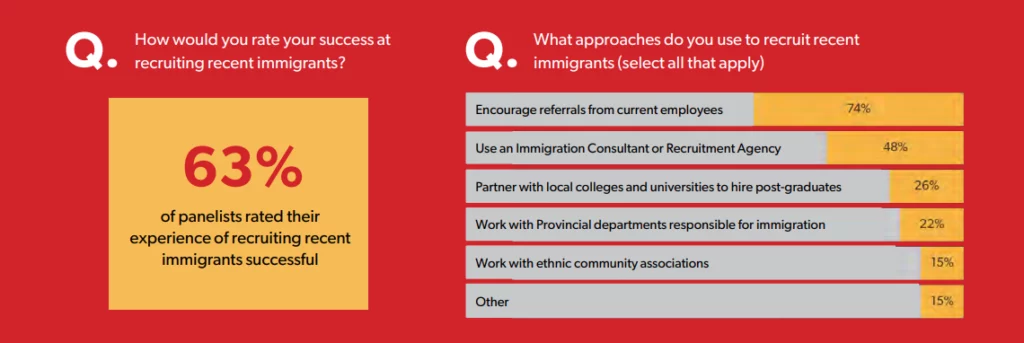
More than half of respondents say their company recruits workers from outside of Canada, and 70% rate their experience as successful.
Of companies that have never recruited international skilled workers from outside of Canada, 53% would consider it.

Companies recruit international skilled workers from all over the world, as seen in the map below. However, the top three countries are the Philippines, Mexico, and France.

Barriers to the recruitment of immigrants and equity-deserving groups mostly come down to costs and complicated processes. About a third of respondents say it’s too expensive to navigate the immigration system. Over a quarter say they don’t understand the process because it’s complicated.
Previous data shows that businesses are open to hiring immigrants and equity-deserving groups, even if they are not doing so currently. Businesses also recognize the benefits of a diverse workforce. Thus, the aspiration to hire from these groups seems to exist, and it’s likely true that once businesses go through the process once, they’re more likely to continue hiring immigrants and equity-deserving groups. This points to a need for ways to simplify or help to streamline the hiring process for businesses.
For companies that are not currently recruiting workers from outside of Canada, the cost and complicated process are the two top reasons why they are not doing so. Processing times are also too long for some, and other companies don’t have the internal capacity to conduct international recruitment.
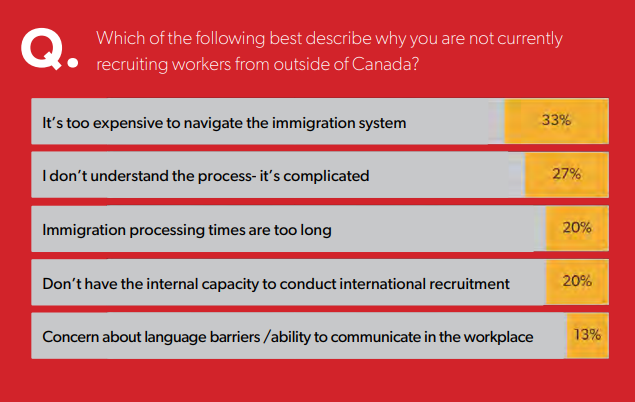
Most respondents (74%) report using the Temporary Foreign Workers Program to support the recruitment of international skilled workers. The next highest program was the Provincial Nominee Program (48%), which varies from province to province. The Express Entry Program, Rural Immigration Program, and Francophone Mobility Program are very rarely used (4% of respondents report using each of these).
There are benefits in using some of the under-utilized immigration pathways, as in some cases, such as with the Francophone Mobility Program, processing times are faster. When an immigrant or international skilled worker is hired, most companies report allowing additional onboarding time (69%). However, only half of companies indicate interest in providing or funding language training. Competency in an official language is an important part of community and workplace integration, as well as a requirement in some immigration pathways.
The Temporary Foreign Workers Program is the top program companies have used to support the recruiting of international skilled workers. Companies have also used Provincial Nominee Programs, the Atlantic Immigration Program, the AgriFood Pilot, and the Canada-Ukraine authorization for emergency travel measures.
Very few companies have used programs such as the Federal Express Entry, Rural Immigration Program, or Francophone Mobility Program.
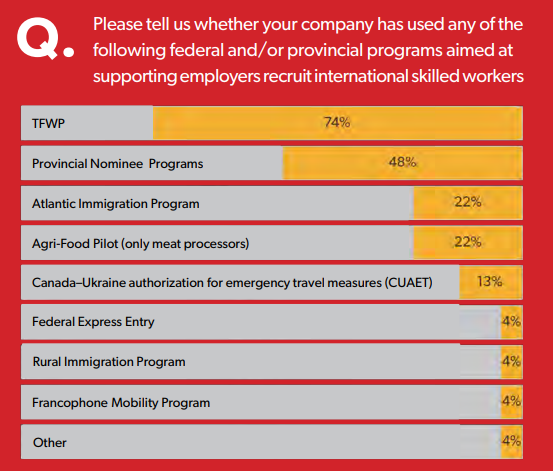
Recruiting from other countries takes longer. There are many
processes to go through to ensure that people coming to
Canada are safe and ready to contribute to our economy.
When developing recruitment strategies, look at the different
immigration programs and requirements to ensure everything
will run as smoothly as possible. One example is looking at the
Post Graduate Work Permit to recruit international graduates
from Canadian post-secondary institutions, as these candidates
are exempt from the Educational Credentials Assessment.
Another strategy is looking at the cut off points between
different immigration options. For example, the low wage
and high wage TFW streams. There are different costs and
responsibilities involved with each stream, but there have
been cases where paying a higher wage was the more
affordable option.
A majority of companies allow additional onboarding time for recent immigrants or international skilled workers. Half of companies would be interested in providing or funding language training for newcomers.

FPSC ran multiple immigration bootcamps in 2023.
Additionally, there are private immigration consultants, immigration-focused organizations, as well as many other resources specifically created to help you succeed at recruiting and integrating Canadian immigrants into your operation.
Have your goal in mind! If you want your newly recruited workers to stay with you in the long term, make sure they have all the documents they need for their PR application before you recruit them.
Stay informed.
Standards can vary when it comes to all the different immigration programs currently available, but there are resources you can take advantage of. For instance, language standards are very different depending on the program you would like to use to recruit your workers, so checking out this CLB breakdown would give you all the information you need to make the right decisions when it comes to your recruitment strategies.

Our next survey is coming out in February, so keep an eye out!
If you are not already signed up to participate in the Rapid
Results Employer Panel, sign up now at rapidresults.ca